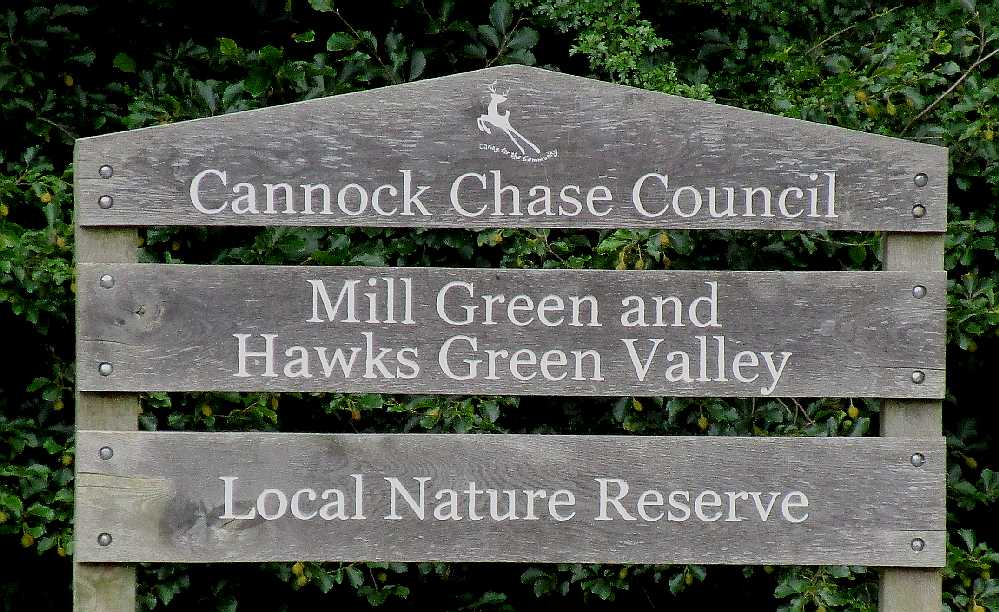 |
Residents and visitors make full and varied use of the green countryside-with-water-features area described below. Originally combined with the nearby Hawks Green, the Mill Green Nature Reserve is tended by the Cannock Chase Council through its Countryside Service. |
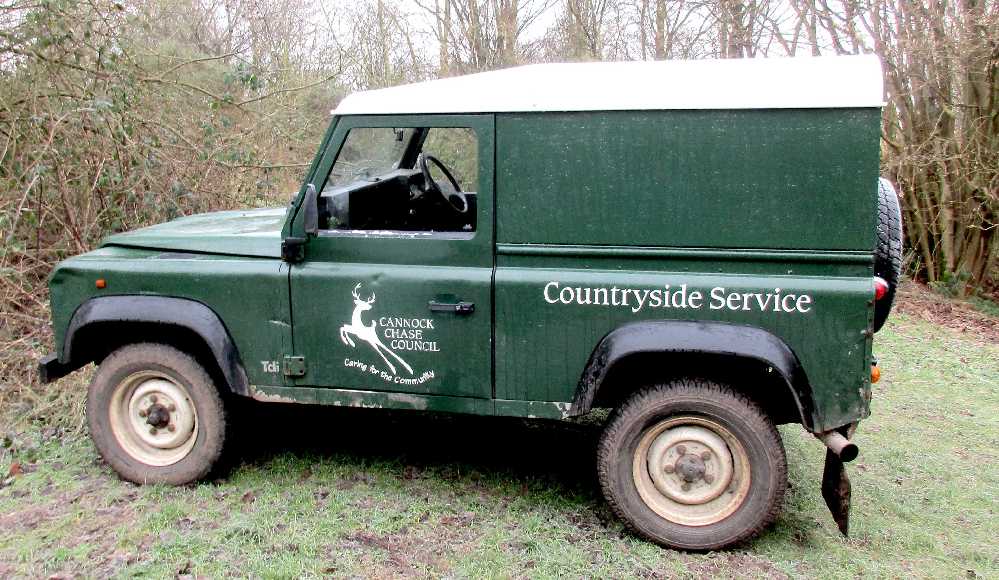 |
 | The main entrance to the Reserve: on the Cannock/Lichfield A5190 road immediately opposite Cannock railway station. Its nearest postcode: WS11 8EE. Its Ordnance Survey grid reference: SJ 986 099 Its satnav location: 52°41'13"N 2°01'18"W 52.686976, -2.021592. <<<<<< Your browser probably lets you enlarge the map image to see more of the details. <<<<<<< |
"The site is surrounded by housing and industrial / commercial development. It is bordered to the west by the Walsall to Rugeley Railway line of 1886 vintage. Cannock station is on the Lichfield Road, which is the southern boundary of the site. The existing station car park and adjacent new housing areas occupy the site of the former Cannock, Hednesford & District Gas Co. gasworks. Gas production lasted until the late 1950s and the last gas holder was removed in the late 198Os. To the east of the site fields ran up to what was the Cannock Extension Canal, now the A460 Eastern Way. Most of this land is now designated for business use. To the north is the Martindale Industrial Estate. From the north-eastern corner of the site a path links over the A460 Eastern Way to the adjoining Hawks Green Nature Reserve - open space areas that entwine around and into the large Hawks Green and Heath Hayes housing areas."
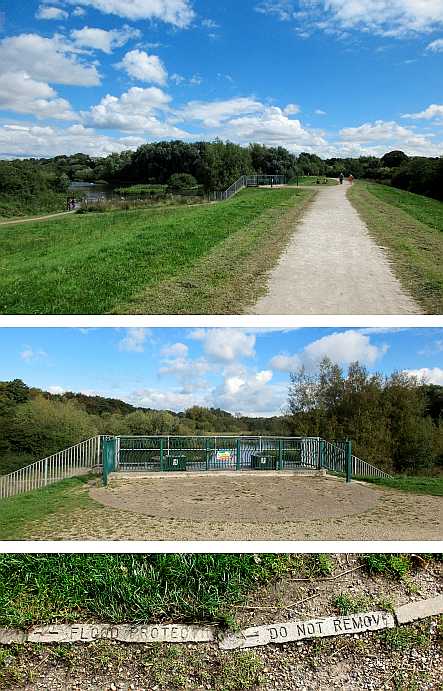 All marked text is taken from the Council's information display board near the entry point from the car park.
All marked text is taken from the Council's information display board near the entry point from the car park.
"HISTORY:
The site was originally agricultural land through which the Ridings Brook flowed in a south westerly direction. The majority of this flow was channelled along a leet to the east of the present brook course to supply water to the mill pool serving the Cannock Mill adjacent to what is now Mill Farm Public House. The 1884 map indicates the mill as a flour mill, then up to l938 as a corn mill. Around the mid l950s the description changed to Cannock Mill Farm. During the late 20th century mining subsidence contributed to the ground becoming boggy and marshy with the eventual formation of a large pond west of the mill pond. By the early l97Os the mill pool had become redundant and was filled in with the flow directed into the pond area.
"This whole site was originally designated in the l970s as open space as part of the Hawks Green and Dugdale Action Area Plan which also resulted in the large housing area now covering Hawks Green and Heath Hayes in the l980s. The site remained in agricultural use up to l977 when a storm-water balancing lake and public open space area were created by Cannock Council, becoming Mill Green Nature Reserve. This first dam was approximately 2.4m (8ft) tall and l37m (450ft) long, constructed of earth with a lm (3ft) wide concrete core. Manually operated penstocks controlled water levels.
"As development in the Cannock area increased, more surface water was directed into Ridings Brook. On several occasions the balancing lake overtopped the dam, causing flooding across the Lichfield Road and further downstream through Bridgetown and across the A5 Watling Street. Notable floods occurred in September 1994, July 1999 and November 2000. Following this last flood the balancing pond was desilted and enlarged. However, further calculations showed that this was still not large enough to prevent regular flooding. Subsequently the Environment Agency looked at ways to deal with this issue and in 2005 rebuilt the dam, increasing its height by just under 2m (6ft) and its length to 218m (715ft), as well as installing automatic penstocks that control the outflow of water."

(If you had imagined that a sluice would be controlled by an operator with a screw valve you now know better. The whole flood control scheme is electro-mechanically monitored and controlled by the Environment Agency.)
"At the same time as the dam was being rebuilt the Chase Heritage Cycle Trail from Cannock to Rugeley was being built. The new dam incorporated the Trail along its length as it ran through the Nature Reserve.
"WOODLAND:
Most of the woodland within the nature reserve is of fairly recent origin having been planted since 1980. However, there is one small area of ancient woodland surviving within the nature reserve boundary. To be considered 'ancient' the woodland must have existed prior to 1600. Here the ground flora is noticeably richer than in more recent woodland, with an abundance of wildflowers in early spring. At this time there are masses of native bluebell mixed with the white flowers of the greater stitchwort. Wood anemone, an indicator of long established woodland, is present in several parts of the wood. Most of the woodland planting that took place in the 1980s was with tree species native to the UK. Almost all of those tree species, considered native or long established in the UK, can be found growing within the nature reserve boundary making it a great place to learn how to identify them.
"HAY MEADOWS:
These are managed by allowing the grasses to grow from April to the end of July or August. The grass is then cut, dried and baled for use as winter feed for cattle. This traditional management allows a wide range of wild flowers to flourish and in early summer the meadows are ablaze with colour, quite unlike the agriculturally improved grasslands that are normally encountered in the wider countryside. Some of these meadows support over eighty species of wild flower.
"ANCIENT FLOWER-RICH GRASSLAND:
The meadow and flower-rich grassland areas within the nature reserve are amongst the best examples in Staffordshire. It is likely that some have been farmed along traditional lines for hundreds of years.
 "RUSH PASTURES:
"RUSH PASTURES:
These are managed in a different way from the hay meadows. These grasslands are far too wet for hay making and have traditionally been grazed by cattle throughout the spring and summer months. Within the Nature Reserve this traditional management practice is being continued. Only light grazing takes place, with cattle regularly moved between fields in order to give the wild flowers a chance to flower and set seed. These wet pastures are very rich in plant species associated with damp grassland. This habitat type is now very uncommon in lowland Staffordshire due to land drainage and changes in management.
"FEN AND OPEN WATER:
Around the pool at Mill Green there are areas of species-rich fen. These are areas where the water level is at or close to the land surface. Plants such as reed, sweet-grass and reedmace tend to be dominant but there is a wide range of other wetland species present such as skull cap, meadowsweet, purple loosestrife and wild angelica. In autumn and winter the fen provides habitat for birds such as snipe and water rail. The open water areas are attractive to birds throughout the year. In winter the usual mallard and Canada geese are joined by small flocks of teal many of which breed in Scandinavia or further east in northern Russia."
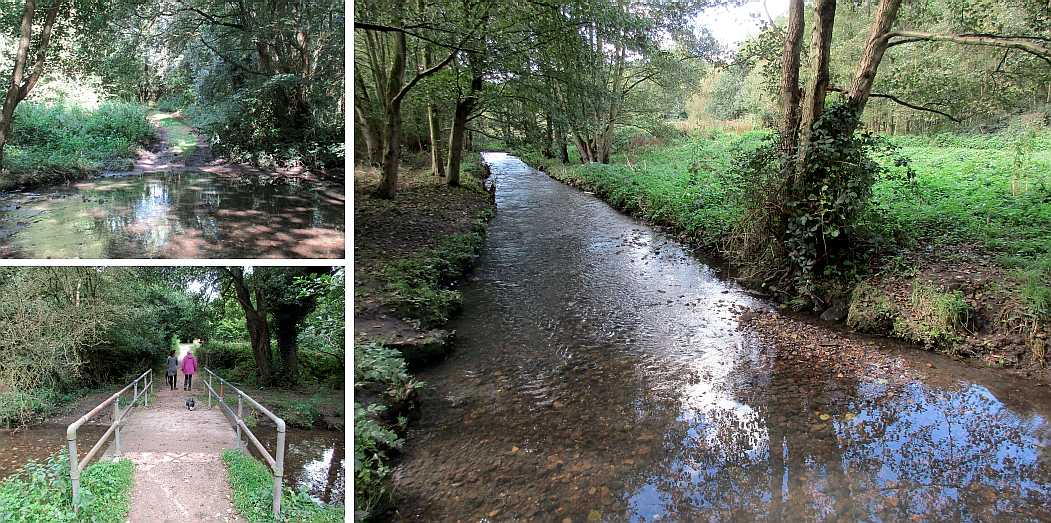
 All marked text is taken from the Council's information display board near the entry point from the car park.
All marked text is taken from the Council's information display board near the entry point from the car park."HISTORY:
The site was originally agricultural land through which the Ridings Brook flowed in a south westerly direction. The majority of this flow was channelled along a leet to the east of the present brook course to supply water to the mill pool serving the Cannock Mill adjacent to what is now Mill Farm Public House. The 1884 map indicates the mill as a flour mill, then up to l938 as a corn mill. Around the mid l950s the description changed to Cannock Mill Farm. During the late 20th century mining subsidence contributed to the ground becoming boggy and marshy with the eventual formation of a large pond west of the mill pond. By the early l97Os the mill pool had become redundant and was filled in with the flow directed into the pond area.
"This whole site was originally designated in the l970s as open space as part of the Hawks Green and Dugdale Action Area Plan which also resulted in the large housing area now covering Hawks Green and Heath Hayes in the l980s. The site remained in agricultural use up to l977 when a storm-water balancing lake and public open space area were created by Cannock Council, becoming Mill Green Nature Reserve. This first dam was approximately 2.4m (8ft) tall and l37m (450ft) long, constructed of earth with a lm (3ft) wide concrete core. Manually operated penstocks controlled water levels.
"As development in the Cannock area increased, more surface water was directed into Ridings Brook. On several occasions the balancing lake overtopped the dam, causing flooding across the Lichfield Road and further downstream through Bridgetown and across the A5 Watling Street. Notable floods occurred in September 1994, July 1999 and November 2000. Following this last flood the balancing pond was desilted and enlarged. However, further calculations showed that this was still not large enough to prevent regular flooding. Subsequently the Environment Agency looked at ways to deal with this issue and in 2005 rebuilt the dam, increasing its height by just under 2m (6ft) and its length to 218m (715ft), as well as installing automatic penstocks that control the outflow of water."

(If you had imagined that a sluice would be controlled by an operator with a screw valve you now know better. The whole flood control scheme is electro-mechanically monitored and controlled by the Environment Agency.)
"At the same time as the dam was being rebuilt the Chase Heritage Cycle Trail from Cannock to Rugeley was being built. The new dam incorporated the Trail along its length as it ran through the Nature Reserve.
"WOODLAND:
Most of the woodland within the nature reserve is of fairly recent origin having been planted since 1980. However, there is one small area of ancient woodland surviving within the nature reserve boundary. To be considered 'ancient' the woodland must have existed prior to 1600. Here the ground flora is noticeably richer than in more recent woodland, with an abundance of wildflowers in early spring. At this time there are masses of native bluebell mixed with the white flowers of the greater stitchwort. Wood anemone, an indicator of long established woodland, is present in several parts of the wood. Most of the woodland planting that took place in the 1980s was with tree species native to the UK. Almost all of those tree species, considered native or long established in the UK, can be found growing within the nature reserve boundary making it a great place to learn how to identify them.
"HAY MEADOWS:
These are managed by allowing the grasses to grow from April to the end of July or August. The grass is then cut, dried and baled for use as winter feed for cattle. This traditional management allows a wide range of wild flowers to flourish and in early summer the meadows are ablaze with colour, quite unlike the agriculturally improved grasslands that are normally encountered in the wider countryside. Some of these meadows support over eighty species of wild flower.
"ANCIENT FLOWER-RICH GRASSLAND:
The meadow and flower-rich grassland areas within the nature reserve are amongst the best examples in Staffordshire. It is likely that some have been farmed along traditional lines for hundreds of years.
 "RUSH PASTURES:
"RUSH PASTURES:These are managed in a different way from the hay meadows. These grasslands are far too wet for hay making and have traditionally been grazed by cattle throughout the spring and summer months. Within the Nature Reserve this traditional management practice is being continued. Only light grazing takes place, with cattle regularly moved between fields in order to give the wild flowers a chance to flower and set seed. These wet pastures are very rich in plant species associated with damp grassland. This habitat type is now very uncommon in lowland Staffordshire due to land drainage and changes in management.
"FEN AND OPEN WATER:
Around the pool at Mill Green there are areas of species-rich fen. These are areas where the water level is at or close to the land surface. Plants such as reed, sweet-grass and reedmace tend to be dominant but there is a wide range of other wetland species present such as skull cap, meadowsweet, purple loosestrife and wild angelica. In autumn and winter the fen provides habitat for birds such as snipe and water rail. The open water areas are attractive to birds throughout the year. In winter the usual mallard and Canada geese are joined by small flocks of teal many of which breed in Scandinavia or further east in northern Russia."

Tracing the main Ridings Brook watercourse, it enters the nature reserve from the Martindale industrial estate, proceeding as a gently rippled flow through dense woodland towards the lake. The very few official vehicles authorised to enter the area can make occasional use of a ford, but the public crossing is the bridge which forms an essential element of the main path for pedestrians, prams and bikes - not to mention dogs. Then a straightened section extends the course, not entirely tree-shaded.

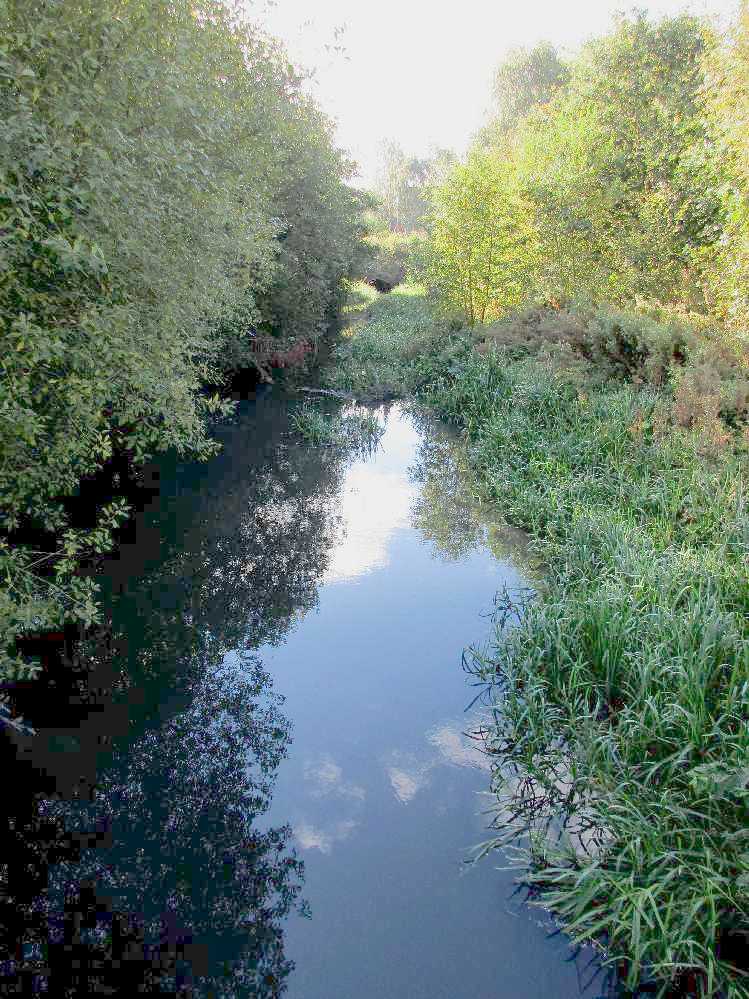 Undoubtedly, the central feature of the Mill Green reserve is the 'lake' or 'balancing pond'. Although managed as a reservoir it is only at times of flood risk that there is any great depth of water. Indeed, many of the waterfowl paddle rather than swim when they're near the edges of the watercourse.
Undoubtedly, the central feature of the Mill Green reserve is the 'lake' or 'balancing pond'. Although managed as a reservoir it is only at times of flood risk that there is any great depth of water. Indeed, many of the waterfowl paddle rather than swim when they're near the edges of the watercourse.
The flow, regulated by the sluice, passes through the dam and continues in a generally southward direction to pass under the Lichfield Road.
But there's another path - another feature - another environment - an absolute favourite of many visitors: it's the beech woodland running alongside the almost invisible railway line, marking the western boundary of the reserve. It's difficult to isolate any one summary photo: click on any of the miniatures below to see the full-screen versions. (Just closing the big picture brings you back here.)
The major animal life forms to be found within the Mill Green Nature Reserve are wildfowl and Cannockians. As regards the former, there is a preponderance of Canada geese and various species of duck (sometimes ill-tempered), together with flighty gulls and, when photographed, one lonesome resident mute swan. Local human residents of all ages delight in making use of the designated duck feeding facility just below the dam.

 Undoubtedly, the central feature of the Mill Green reserve is the 'lake' or 'balancing pond'. Although managed as a reservoir it is only at times of flood risk that there is any great depth of water. Indeed, many of the waterfowl paddle rather than swim when they're near the edges of the watercourse.
Undoubtedly, the central feature of the Mill Green reserve is the 'lake' or 'balancing pond'. Although managed as a reservoir it is only at times of flood risk that there is any great depth of water. Indeed, many of the waterfowl paddle rather than swim when they're near the edges of the watercourse.The flow, regulated by the sluice, passes through the dam and continues in a generally southward direction to pass under the Lichfield Road.
| The path around the nature reserve is a single loop with a feed-in from the Lichfield road car park. It is hard enough to be reasonably weather-proof though robust footwear is helpful when conditions are poor. It extends from the whole width of the dam at one end up to the bridge at the other: it features as a walk4life route. But there are other, less official access routes from the A460 and industrial estate sides. Rumour has it that the whole of the main path will be tarmac surfaced when the 'Outlet Village' is developed next door. |
 |
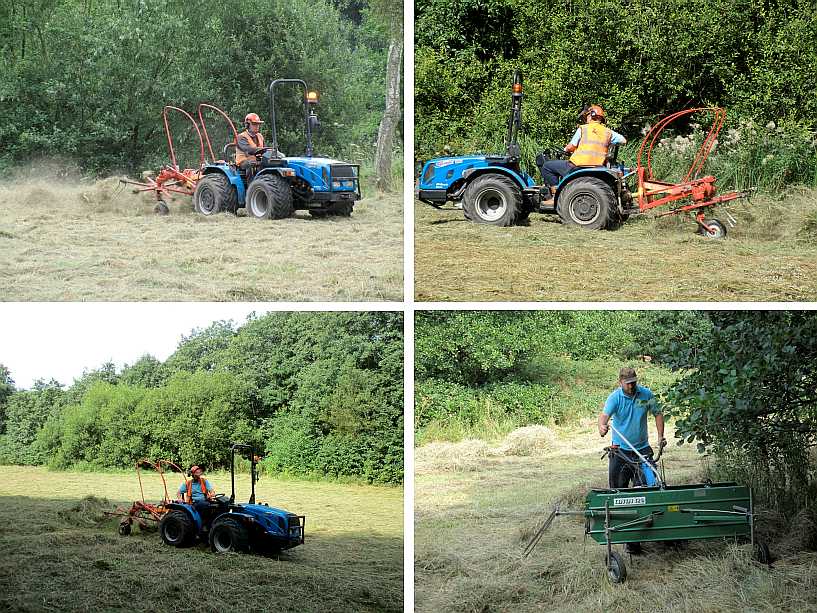 |
Within the circuit of the main path are two grassland paddocks, one each side of the watercourse. But whereas the grass areas around the dam are mown as recreational spaces the paddocks are reserved as conservation areas, designated as flower-rich meadows with no public access. Summer growth is allowed to reach flowering and seed-setting phase before being cut as a hay crop, pictured here being tedded (fluffed up to speed the drying process) in July and August. The whole crop is baled and removed off-site, deliberately preventing any build-up of soil fertility. The VALIANT 500 four-wheel drive power unit was specially selected for use on the reserve: its very low centre of gravity provides a vital safety feature when used for mowing the sloping sides of the earth dam. |
But there's another path - another feature - another environment - an absolute favourite of many visitors: it's the beech woodland running alongside the almost invisible railway line, marking the western boundary of the reserve. It's difficult to isolate any one summary photo: click on any of the miniatures below to see the full-screen versions. (Just closing the big picture brings you back here.)
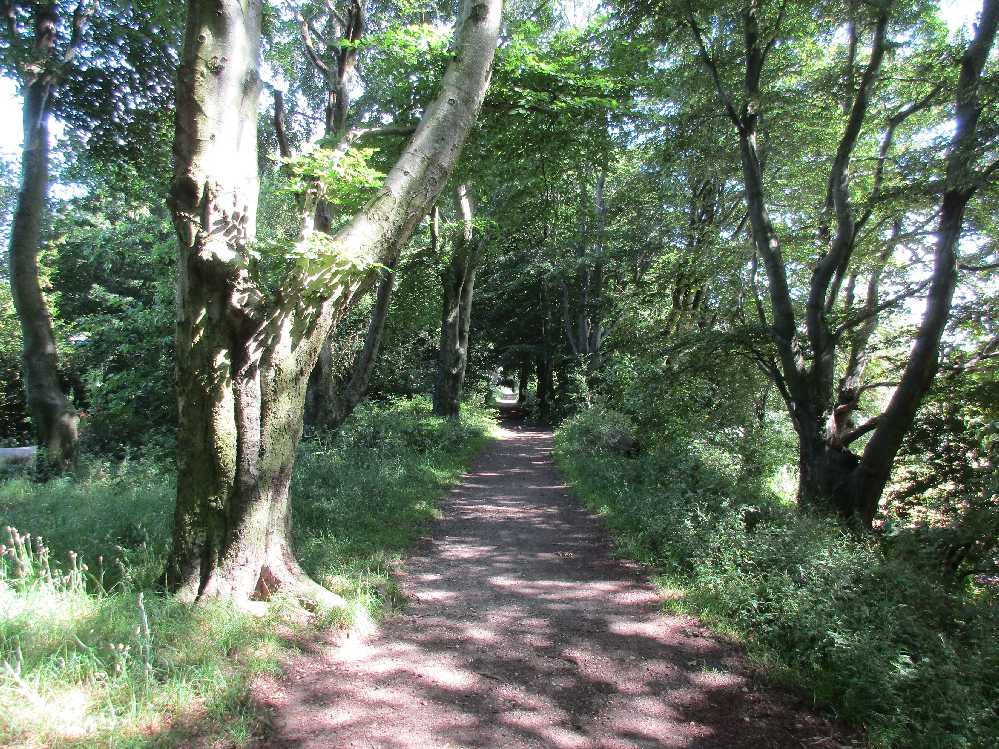 |
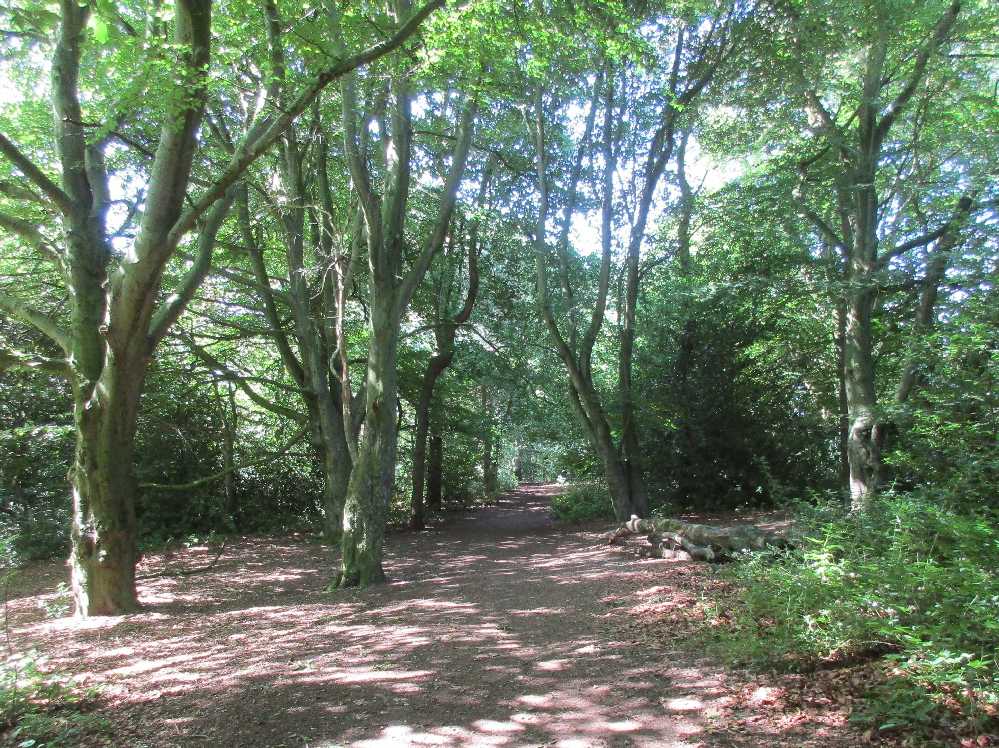 |
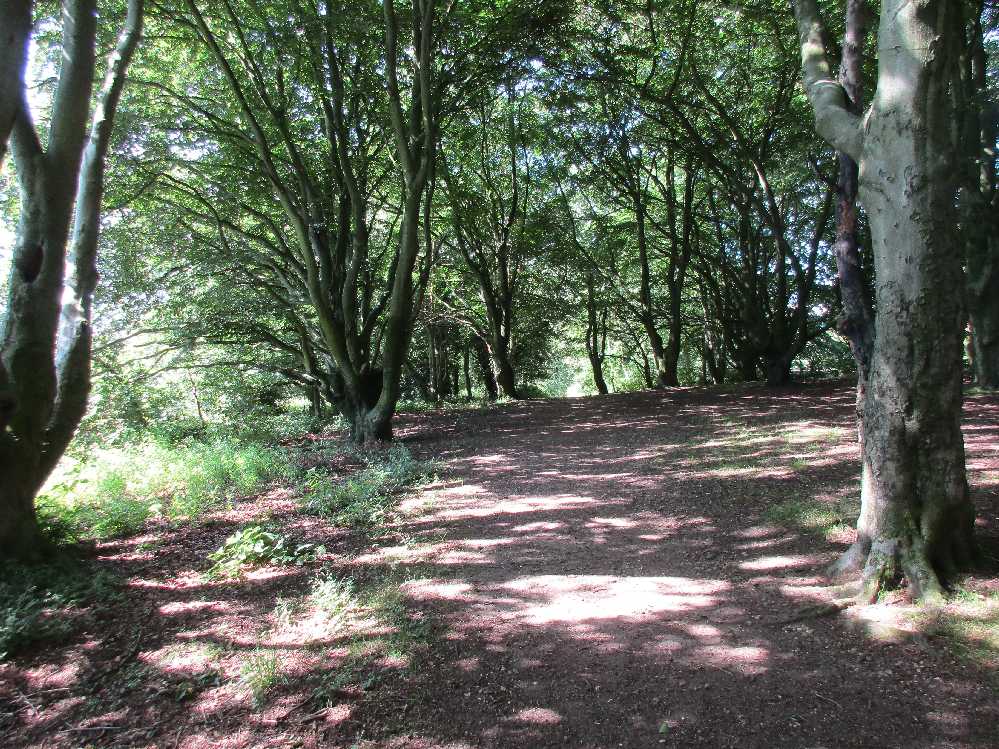 |
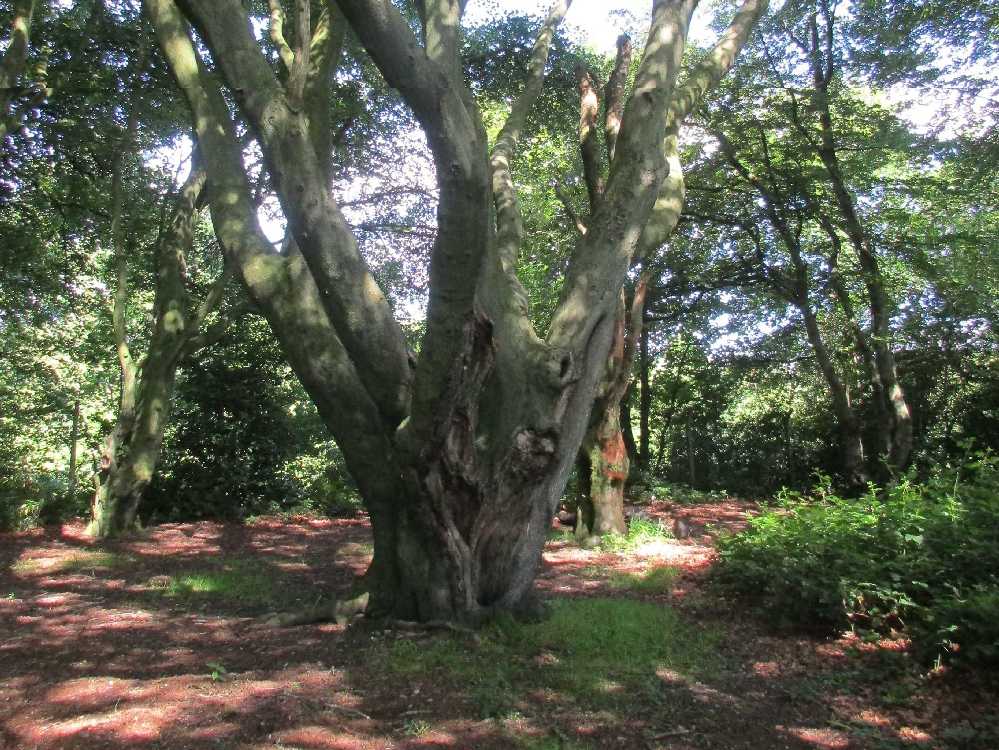 |
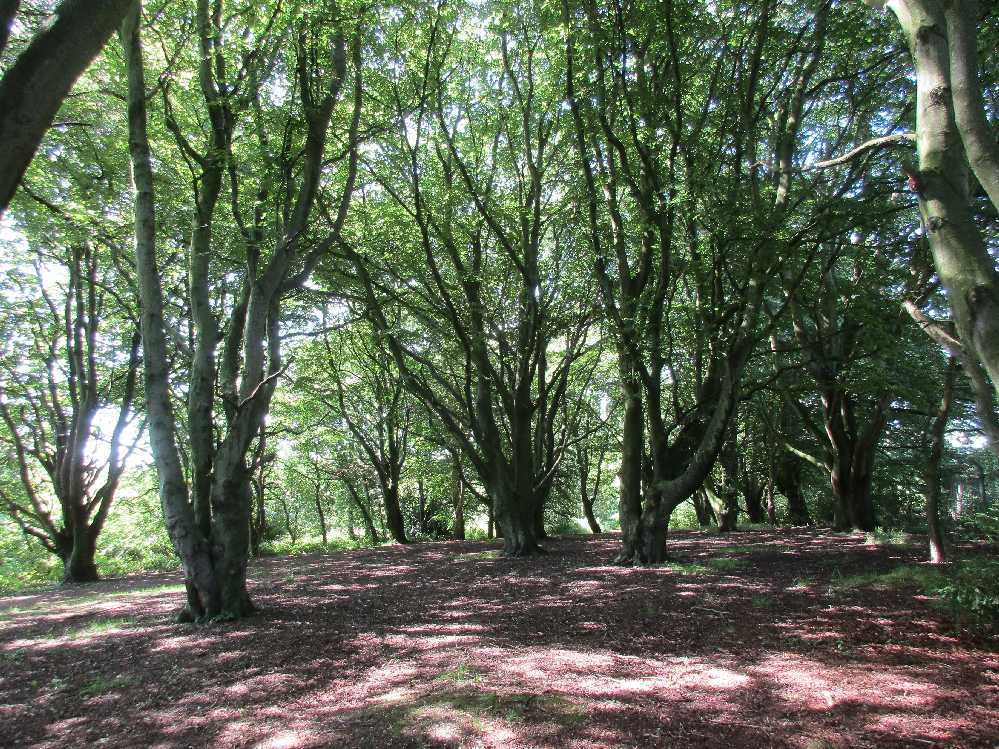 |
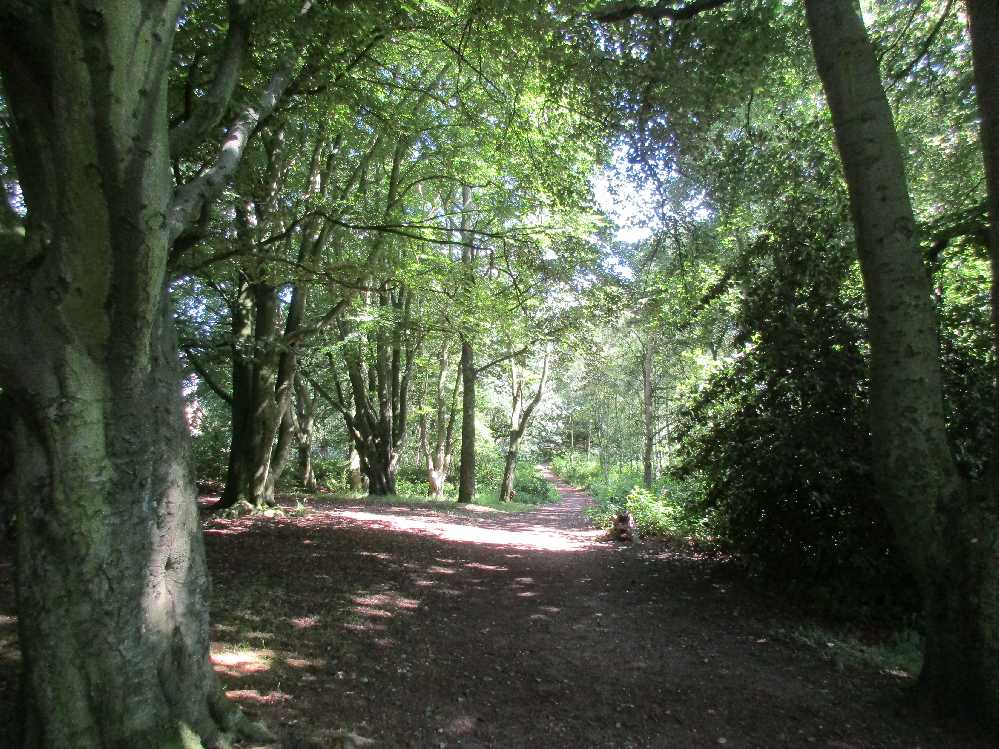 |
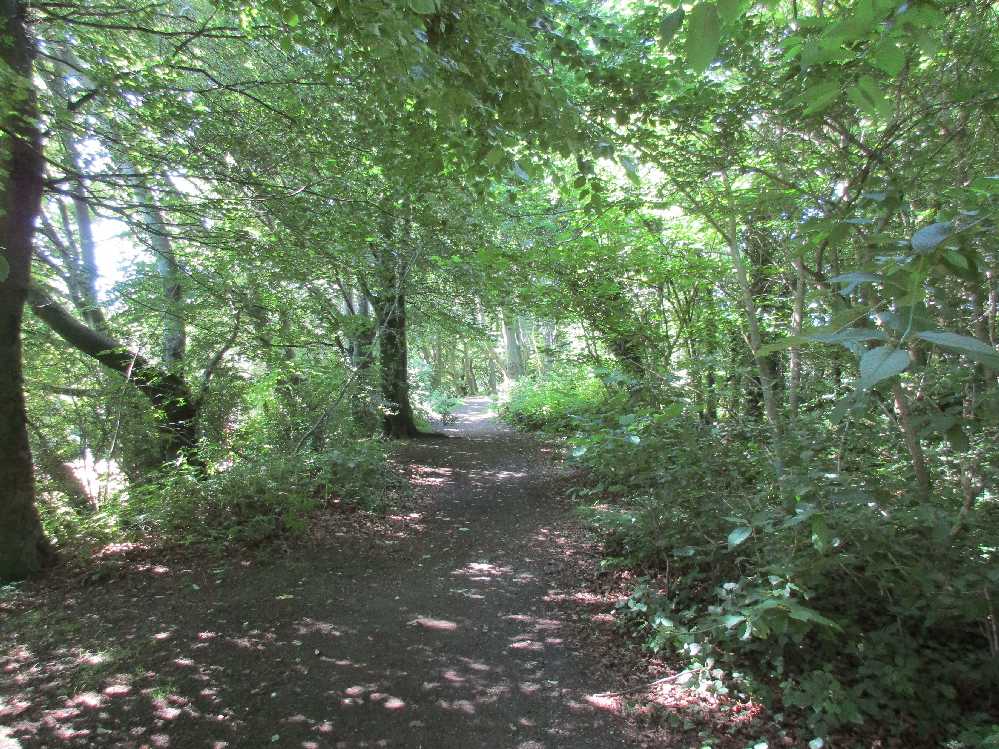 |
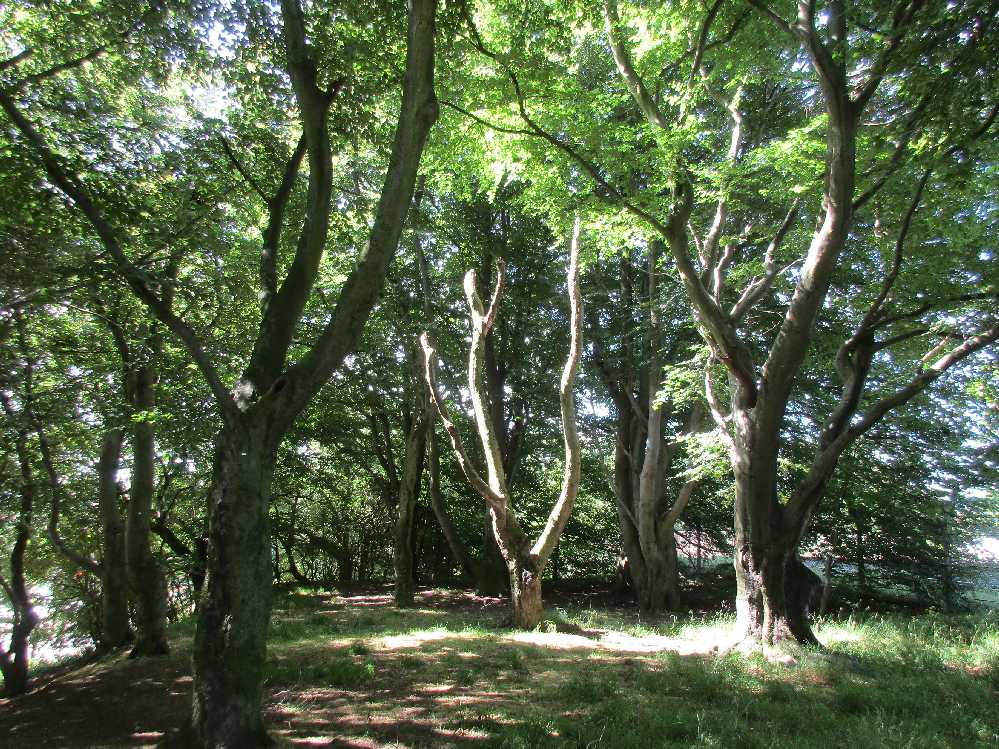 |
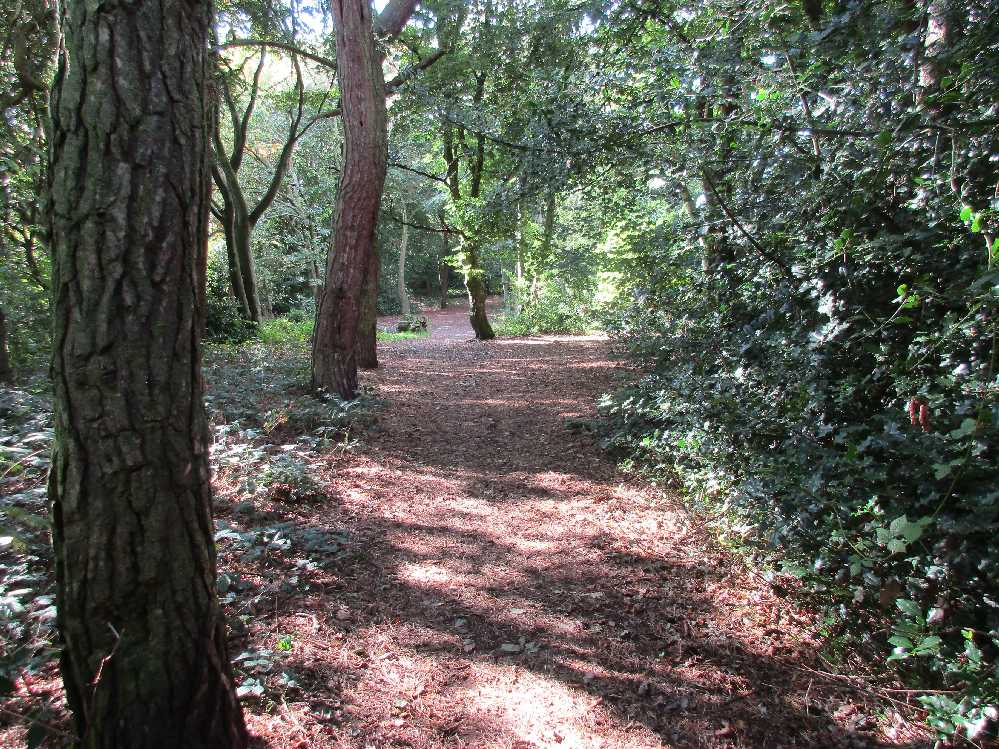 |
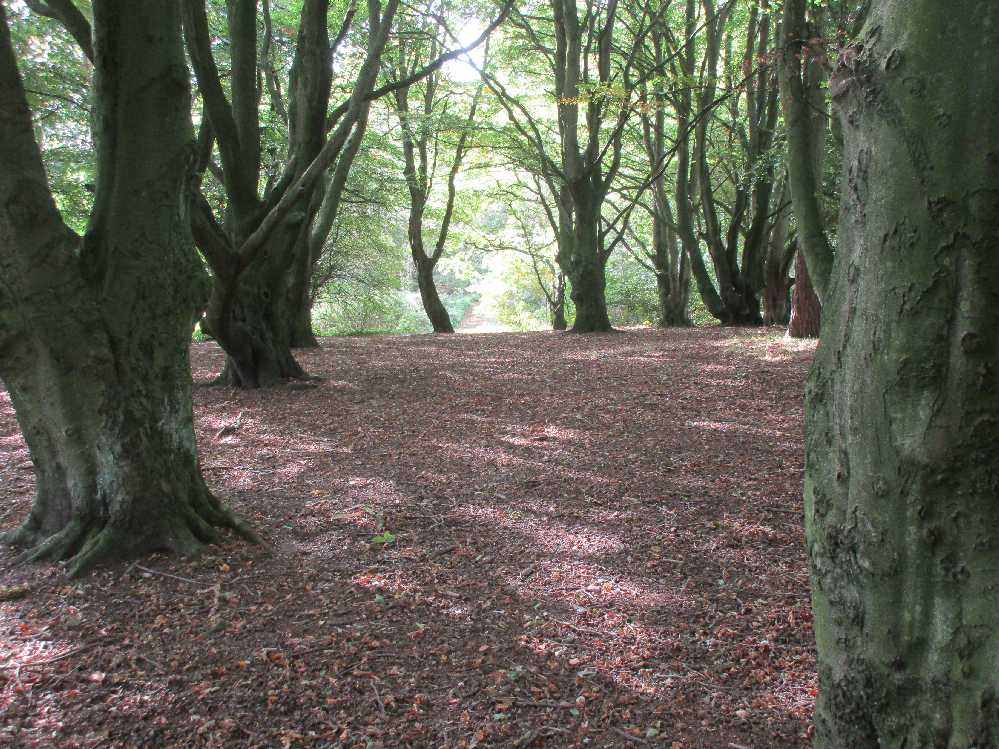 |
The major animal life forms to be found within the Mill Green Nature Reserve are wildfowl and Cannockians. As regards the former, there is a preponderance of Canada geese and various species of duck (sometimes ill-tempered), together with flighty gulls and, when photographed, one lonesome resident mute swan. Local human residents of all ages delight in making use of the designated duck feeding facility just below the dam.
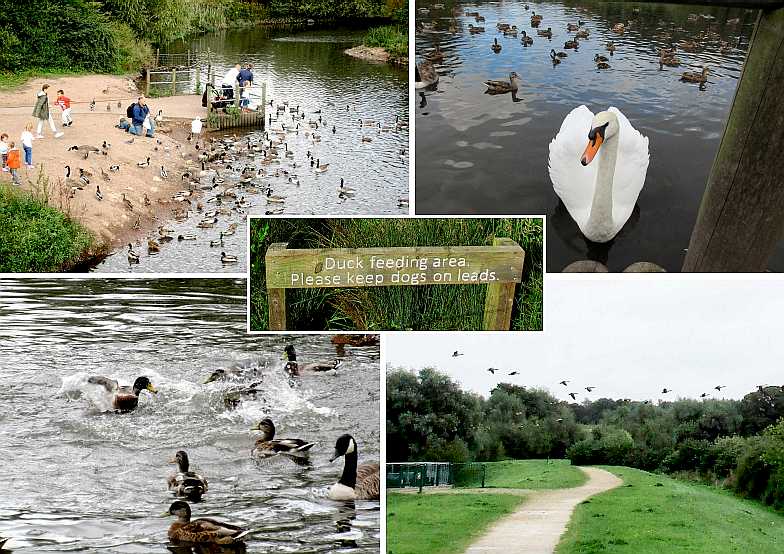
Ducks and geese are always present though not necessarily the same individuals: groups may be seen flying in or away occasionally.
But the smaller forms of animal life may well be more significant, in total through the whole year. A difficulty in the current context is that few of them ever pose long enough to be photographed, within range of any non-professional lens at least. Numbers are simply impossible to discover.
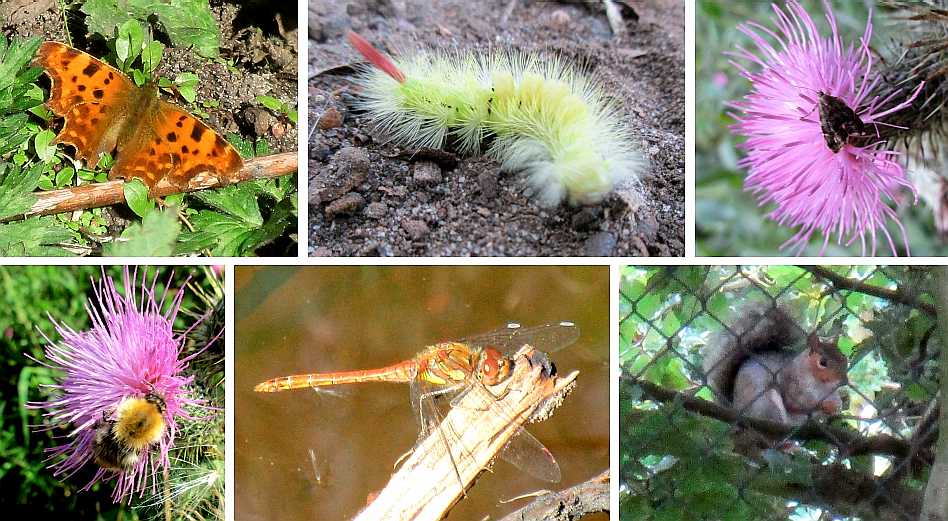
This mini-selection comprises a comma butterfly; the caterpillar of a pale tussock moth; an unknown species of moth; what is thought to be a tree bumblebee; a common darter dragonfly; and a grey squirrel (on the wrong side of the fence, photographically speaking), regarded by some as a 'tree rat' because of the damage it causes, principally by bark stripping.
Again, some residents are known to be present only by virtue of the evidence they leave behind. Hungry badgers are thought to be responsible for the snuffled-up grassy patches, along the sides of the paths particularly: they would have been in search of earthworms there. There are small numbers of rabbits on the Reserve, but they are very shy and are decimated by myxomatosis from time to time. A feature of a nature reserve as distinct from an area of commercial forestry is that some timber is deliberately left to rot. In the process it is colonised by various beetles and suchlike which lay eggs that turn into fat, nutritious and doubtless tasty grubs. Discovered by those badgers, the softened material may need to be torn apart in sorting the tasty from the inert.

This mini-selection comprises a comma butterfly; the caterpillar of a pale tussock moth; an unknown species of moth; what is thought to be a tree bumblebee; a common darter dragonfly; and a grey squirrel (on the wrong side of the fence, photographically speaking), regarded by some as a 'tree rat' because of the damage it causes, principally by bark stripping.
Again, some residents are known to be present only by virtue of the evidence they leave behind. Hungry badgers are thought to be responsible for the snuffled-up grassy patches, along the sides of the paths particularly: they would have been in search of earthworms there. There are small numbers of rabbits on the Reserve, but they are very shy and are decimated by myxomatosis from time to time. A feature of a nature reserve as distinct from an area of commercial forestry is that some timber is deliberately left to rot. In the process it is colonised by various beetles and suchlike which lay eggs that turn into fat, nutritious and doubtless tasty grubs. Discovered by those badgers, the softened material may need to be torn apart in sorting the tasty from the inert.
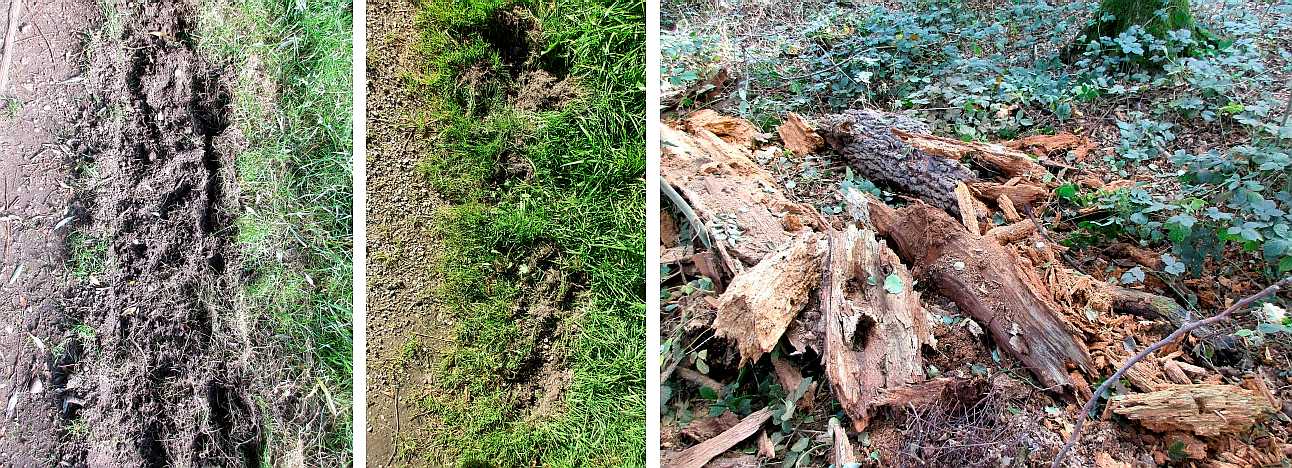
Lest it be thought that the nature reserve is exclusively green, just grasses and trees, here's a small selection of sexy summer inflorescences.
 Greater burnet saxifrage : poppy : bindweed : marsh bird's foot trefoil : cow parsley.
Greater burnet saxifrage : poppy : bindweed : marsh bird's foot trefoil : cow parsley.Ragwort : bramble : great willowherb : water mint (with bee) : teasel.
So why does one other type of flower need a row all to itself?

| Obviously beautiful, it is known to be a rich source of late-summer nectar. But as the name - Himalayan balsam - implies, it's a foreigner. As the flowers fade, flask-shaped seed pods develop, containing masses of seeds. The seeds don't just drop out: when they're ripe the sides of the pods burst open almost explosively, throwing the seeds around, thus expanding the area of infestation. (Photos were taken in Yorkshire!) So although this year's plants die off those seeds will germinate anywhere next spring giving a new generation of aggressive invaders. Unwanted. If you spot it, pull it up gently and put it in a litter bin please. | 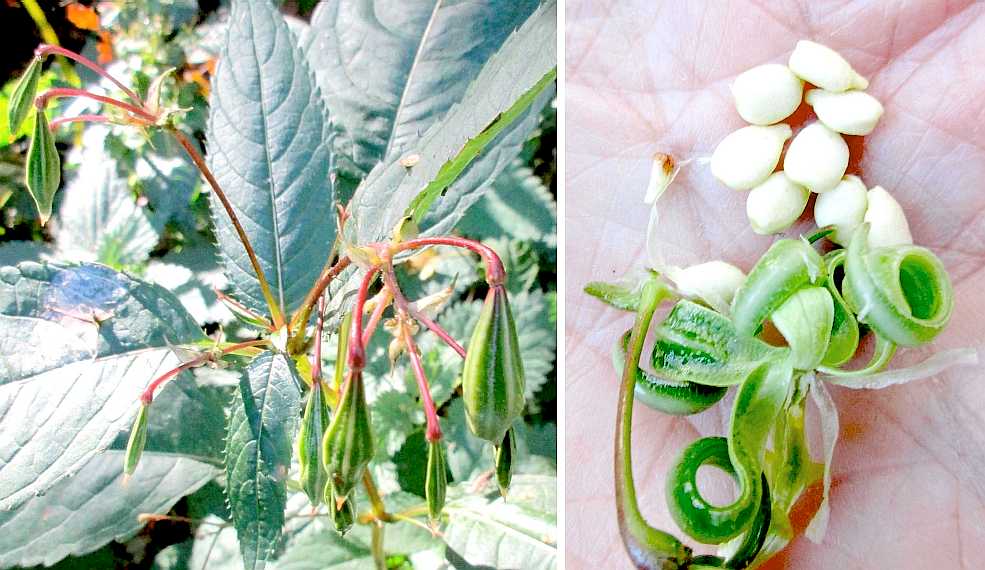 |
But we also have, here in our metaphorical back yard, a practical demonstration of the operation of the carbon cycle which is causing such disquiet in the contexts of energy production, global warming, sea level rise and ecological survival in general. It all starts with light, sunlight specifically. All green plants (plus some others such as copper beech trees and red seaweeds) use the energy of sunlight to turn water from the soil and carbon dioxide from the air into biological matter - first as simple sugars and then into the whole gamut of proteins, carbohydrates, cellulose, oils, and ... so on.
Mother Nature is so keen to make the most of this whole operation that, over the aeons of evolution, trees have grown tall to grab their unfair share of sunlight. Pictures above showed the lack of any vegetation on the ground under mature beech trees. Where the darkness is not quite so profound sparse grass growth may survive, or denser ivy perhaps. Some non-flowering plants are past masters in the shade, ferns in particular.

OK! So plants can build up their own roots and stems and leaves and flowers. But they lose their flowers one way or another, and the leaves die back or drop off at the end of every year - except the 'evergreens' of course. The unseen, unrecognised, under-valued workers responsible for recycling all the dead leaves and other no-longer-needed stuff are the fungi. Now every fungus is made up of microscopic threads that are invisible. (It's only when hundreds of threads have grown together that you can see that your stale bread has gone mouldy.) In the woodland context, the whole of the soil and leaf litter, diseased timber and dead wood, has fungus threads already present or growing into it. The fungi are not green - there's no light there anyway - so they can't build themselves up using water and carbon dioxide. Instead they live by breaking down the material already built up by the green plants. And like us and almost every other living thing (including green plants at night) they breathe: that's the most important way nature supplies fresh carbon dioxide to the atmosphere.
The only time we casual observers can see any of these fungi for ourselves is when they form themselves into so-called 'fruiting bodies', which are responsible for forming their microscopic seeds known as 'spores' and distributing them on even the lightest of breezes. Those fruiting bodies commonly appear as toadstools (including edible mushrooms), bracket fungi, puff-balls (the brown puff is trillions of spores) and everything in between. We'll start off with examples of the ones that are there all year round, usually lasting several or many years - bracket fungi. They produce the next batch of spores by growing a new fringe each year.

There are other reasons why the fungi don't have a very public public image. Their toadstools, for example, are there for only a few days or weeks in the year, almost restricted to the autumn and early winter. Some are quite tiny. Some provide a food source for various creatures so they don't last long. Some others, intent solely on releasing their spores, are so well disguised that they are noticed only by specialists hunting them out.

All that group were short-lived, growing on and getting their nourishment from the ground. Most of the fungi which rot down dead timber (often assisted by sundry insects and their larvae) also produce fruiting bodies. But unlike the bracket fungi, the examples below are made of soft tissue: they erupt over a period of just a few days, last a week or so, and then seem almost to dissolve, perhaps being re-absorbed, leaving no trace after a month.

After summer flowering, with wind or insect pollination, the green plant cycle is completed with the formation of seeds to start the next generation. But to improve the chances of achieving a geographical spread those seeds are in many cases encased in fruits which encourage consumption by mobile creatures - birds, mice or squirrels in the cases shown.

Bramble/blackberry : oak/acorn : beech/mast : hawthorn/berry.
"MANAGEMENT and MAINTENANCE:
The site is managed by Cannock Chase Council's Countryside Service who run a weekly volunteer programme. If you would like to become involved with looking after this or other countryside sites within the District please contact the Countryside Service on 01543 450018, or for more information on the Service and its other sites, take a look at the Countryside section of the Council's website, here. If you have any comments or concerns about the Nature Reserve site please contact the Countryside Service on the number above or in any emergency contact the police, fire or ambulance service."

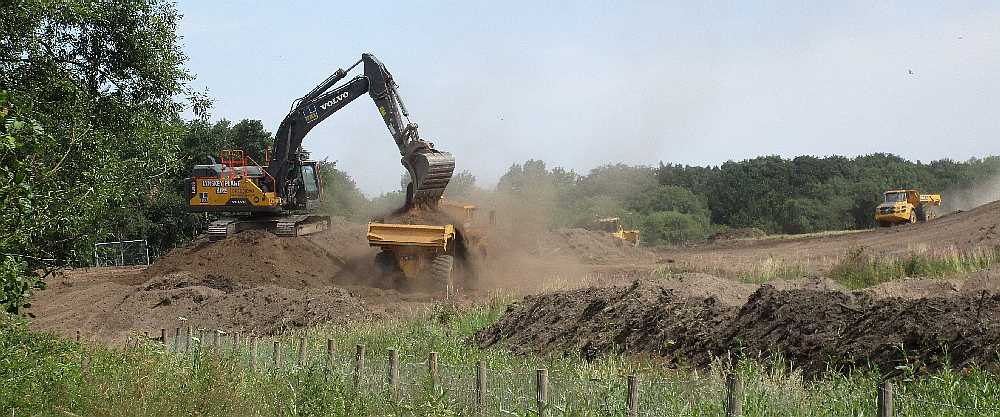
The last weeks of February 2018 marked an historic threshold, as site clearance machinery took over the adjoining land to the east of the Reserve. It signified initial preparation for the development of the Mill Green Outlet Village. But that was only for the preliminary fencing and boundary works: site works proper did not begin until the middle of July, 2018.
Thanks to the new drone technology and generous contributions of Steve Moore Photography it is possible to include views of the Nature Reserve which could previously be enjoyed only by seagulls and the like. That's January on the left, while the July 2018 picture captures the drought summer that kept the grasslands brown after being mown or cut for hay, and the start of development on the adjoining land.
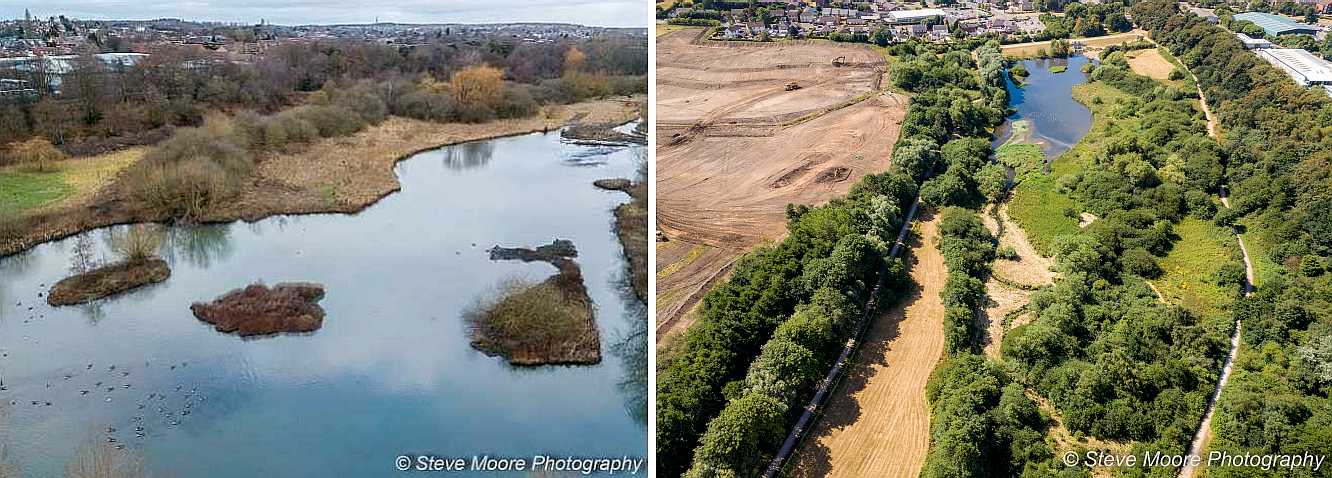
 1 • The bird feeders are refilled by Council staff and volunteers, benefiting this great tit and many others.
1 • The bird feeders are refilled by Council staff and volunteers, benefiting this great tit and many others.
2 • A bullfinch seemed shy about approaching the feeder, but his pink waistcoat shined through the undergrowth.
3 • For the first time for several years an "ugly duckling, its feathers all stubby and brown" grew up on the Reserve: it will whiten into a swan in 2019!
4 • Visible, with luck, at all seasons, grey squirrels do not hibernate.
Not a seasonal floral display, nevertheless there were some flowers visible on New Year's Day:
 1 • Red campion normally flowers in the spring and summer. It may be that the 2018 drought upset the plants which later tried to catch up.
1 • Red campion normally flowers in the spring and summer. It may be that the 2018 drought upset the plants which later tried to catch up.
2 • One of the toughest of familiar plants, odd specimens of the humble daisy can usually be found in a careful search.
3 • A few dandelions evidently tried to follow suit, but were not at their best on the crucial day.
4 • Gorse is often a reliable all-year bloomer, but we have very few on the Reserve now that we have lost the adjoining site.
5 • Quite a lot of white deadnettles were to be seen in flower around the main path-sides.
6 • It would be difficult to find an area of wild land that does not have annual meadow grass in flower at every time of year.
7 • Definitely a precursor of displays to come, this primrose was half-hidden behind the base of a tree.
8 • Likely to overtake the primroses, snowdrops come into their own early in January.
9 • But it is not known what this lone specimen was doing, sheltering in a hedge-base: it is thought to be a greater burnet saxifrage.
Some fungi seem to be immune to the effects of frost: they are certainly not affected by the short days and low light levels of wintertime. These were the ones spotted on the New Year's Day circuit of the main pathways. Without an expert mycologist on hand, no attempt has been made to identify them. (But see the "Fungus" page from the menu at the end of this page.)
 1 • The green vegetation is a moss: the brown texture is the bark of an oak tree. The fungus is an unknown miniature mushroom of a type which seems to appear only on moss-grown mature oaks and willows for a few days just before or during the festive season.
1 • The green vegetation is a moss: the brown texture is the bark of an oak tree. The fungus is an unknown miniature mushroom of a type which seems to appear only on moss-grown mature oaks and willows for a few days just before or during the festive season.
2 • Another unusual fungus, in the form of a soft floppy shelf.
3 • These pinkish almost ear-shaped little fruiting bodies are evidence of what is evidently a very common wood-rotting fungus.
4 • These toadstools were along the edge of one of the shredded-wood paths, through the poplar plantation.
5 • Close-by, in addition to another upright fungus there was a pinkish fugal coating on a small dead branch.
6 • Some bracket fungi last several years, usually brown on top but commonly white on the active underside where spores are produced.
Some final features deserved to be included in the New Year record of interests:
 1 • The annual cycle of ivy seems to be miss-timed, with these deep-winter fruits developing after autumn flowering.
1 • The annual cycle of ivy seems to be miss-timed, with these deep-winter fruits developing after autumn flowering.
2 • Unusually, one tree-trunk patch of moss was beginning to show early signs of developing spore-bearing shoots.
3 • Finally, we mustn't expect actually to see any moles, but fresh molehills give evidence that they are are still there, underground, and actively tunnelling.
The site is managed by Cannock Chase Council's Countryside Service who run a weekly volunteer programme. If you would like to become involved with looking after this or other countryside sites within the District please contact the Countryside Service on 01543 450018, or for more information on the Service and its other sites, take a look at the Countryside section of the Council's website, here. If you have any comments or concerns about the Nature Reserve site please contact the Countryside Service on the number above or in any emergency contact the police, fire or ambulance service."


The last weeks of February 2018 marked an historic threshold, as site clearance machinery took over the adjoining land to the east of the Reserve. It signified initial preparation for the development of the Mill Green Outlet Village. But that was only for the preliminary fencing and boundary works: site works proper did not begin until the middle of July, 2018.
Thanks to the new drone technology and generous contributions of Steve Moore Photography it is possible to include views of the Nature Reserve which could previously be enjoyed only by seagulls and the like. That's January on the left, while the July 2018 picture captures the drought summer that kept the grasslands brown after being mown or cut for hay, and the start of development on the adjoining land.

NEW YEAR'S DAY 2019:
The turn of the year can be taken as a write-off of the old year and a welcome for the new. A walk round the Nature Reserve revealed some residual long-lasters, some early predictors, and one or two mysteries. 1 • The bird feeders are refilled by Council staff and volunteers, benefiting this great tit and many others.
1 • The bird feeders are refilled by Council staff and volunteers, benefiting this great tit and many others.2 • A bullfinch seemed shy about approaching the feeder, but his pink waistcoat shined through the undergrowth.
3 • For the first time for several years an "ugly duckling, its feathers all stubby and brown" grew up on the Reserve: it will whiten into a swan in 2019!
4 • Visible, with luck, at all seasons, grey squirrels do not hibernate.
 | One of the mysteries was the appearance, in many parts of the Reserve, of small white downy feathers. They seem to have been cast off by birds in flight as they are always clean and undamaged when they reach the ground. But which birds? And why do they shed any part of their undies in mid-winter? Can you help? |
 1 • Red campion normally flowers in the spring and summer. It may be that the 2018 drought upset the plants which later tried to catch up.
1 • Red campion normally flowers in the spring and summer. It may be that the 2018 drought upset the plants which later tried to catch up.2 • One of the toughest of familiar plants, odd specimens of the humble daisy can usually be found in a careful search.
3 • A few dandelions evidently tried to follow suit, but were not at their best on the crucial day.
4 • Gorse is often a reliable all-year bloomer, but we have very few on the Reserve now that we have lost the adjoining site.
5 • Quite a lot of white deadnettles were to be seen in flower around the main path-sides.
6 • It would be difficult to find an area of wild land that does not have annual meadow grass in flower at every time of year.
7 • Definitely a precursor of displays to come, this primrose was half-hidden behind the base of a tree.
8 • Likely to overtake the primroses, snowdrops come into their own early in January.
9 • But it is not known what this lone specimen was doing, sheltering in a hedge-base: it is thought to be a greater burnet saxifrage.
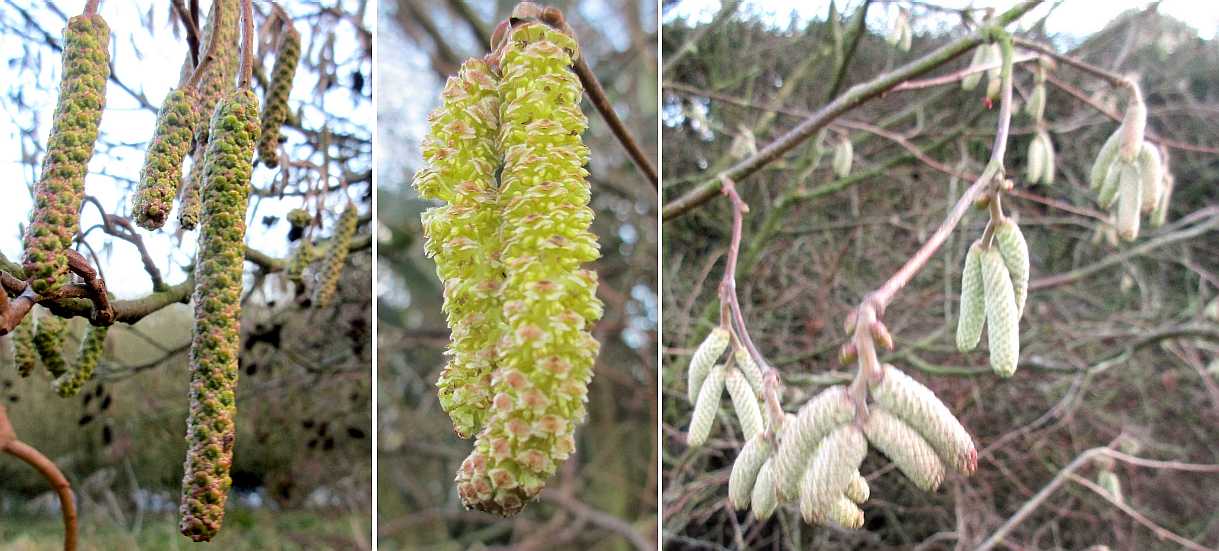 | By far the commonest flowers at the turn of any year are the catkins on a variety of trees including hazel and alder. They don't have any insect-attractive petals because they rely on pollen transfer by the winter winds, breezes even. The male pollen producers tend to be more obvious than the females. |
| Ferns never have any flowers at all! But some kinds do tend to keep their leaves in working order so that they are able to make best use of winter sunlight for building up reserves ahead of reproduction by spores next autumn. There are more details on the "Minor Vegetation" page: see the link near the end of this page. | 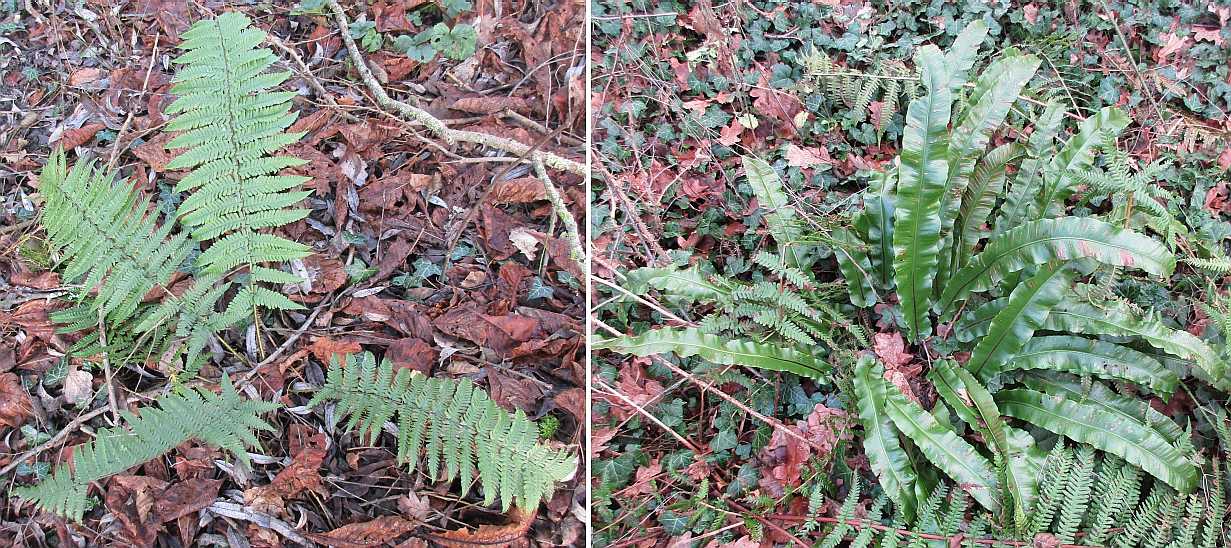 |
 1 • The green vegetation is a moss: the brown texture is the bark of an oak tree. The fungus is an unknown miniature mushroom of a type which seems to appear only on moss-grown mature oaks and willows for a few days just before or during the festive season.
1 • The green vegetation is a moss: the brown texture is the bark of an oak tree. The fungus is an unknown miniature mushroom of a type which seems to appear only on moss-grown mature oaks and willows for a few days just before or during the festive season.2 • Another unusual fungus, in the form of a soft floppy shelf.
3 • These pinkish almost ear-shaped little fruiting bodies are evidence of what is evidently a very common wood-rotting fungus.
4 • These toadstools were along the edge of one of the shredded-wood paths, through the poplar plantation.
5 • Close-by, in addition to another upright fungus there was a pinkish fugal coating on a small dead branch.
6 • Some bracket fungi last several years, usually brown on top but commonly white on the active underside where spores are produced.
Some final features deserved to be included in the New Year record of interests:
 1 • The annual cycle of ivy seems to be miss-timed, with these deep-winter fruits developing after autumn flowering.
1 • The annual cycle of ivy seems to be miss-timed, with these deep-winter fruits developing after autumn flowering.2 • Unusually, one tree-trunk patch of moss was beginning to show early signs of developing spore-bearing shoots.
3 • Finally, we mustn't expect actually to see any moles, but fresh molehills give evidence that they are are still there, underground, and actively tunnelling.
<<<<<<<<<<+>>>>>>>>>>
There are some more detailed pages available: click your pick -Animal Life
Trees • Flowers • Fungi • Minor Vegetation
Spring • Summer • Autumn • Winter
or back to the top of this page
| LINKS YOU MAY FIND HELPFUL Our hosts are the Cannock Chase District Council. The Staffordshire Biodiversity Action Plan. Other nature reserves in the area are mostly run by the Staffordshire Wildlife Trust. In a wider context, Natural England is the relevant government agency. THE bird organisation is, of course, the RSPB. Support Staffordshire has interests in Environment, Rural, Sustainability & Animals. |
Mike Hosken provided these words and pictures during the five years that he was resident over the road in Remington Drive. The project combined his interest in nature with a degree of fulfilment in constructing the website from scratch. Management was taken over in 2022 by Cannock Chase District Council, who can be contacted by emailing infomanager@cannockchasedc.gov.uk.